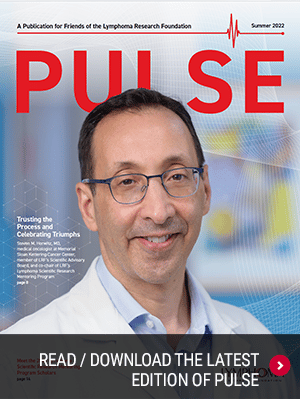Bob, Mantle Cell Lymphoma Survivor
Bob, Mantle Cell Lymphoma Survivor

In August of 2000, after months of not feeling like myself – having trouble sleeping and difficulty breathing – my doctor and I felt something was not right. I had discovered a few lumps around my chin, which at first my doctor deemed as harmless. However, after a CAT scan and a variety of other tests I was diagnosed with mantle cell lymphoma (MCL).
Receiving a cancer diagnosis is not something you can prepare yourself for. I drove home in a state of shock, having no concept of what MCL was or how to deal with it. I told my closest family and friends in person, and my wife and I decided to send an email to those whom we didn’t see as often. What I found interesting about informing others of my diagnosis was, some relatives and friends were extremely helpful, while others seemed to back off. I think that they didn’t know what to say or what to do. However, truth be known, there are also many moments when you don’t want to talk about it – and that is ok too.
“While I was still unsure of what was about to unfold, I was lucky enough to have a team of doctors that I trusted.”
While I was still unsure of what was about to unfold, I was lucky enough to have a team of doctors that I trusted. We followed the treatment plan they put together for me, which started with chemotherapy followed by an autologous stem cell transplant in February of 2001. The biggest challenges were the intense chemotherapy I had to undergo and having to spend three and a half weeks in the hospital – but I got to know a couple of people, and we spent our time roaming the hospital for exercise to help pass the time. It took about a year and a half to feel like myself again, but then in August of 2004, I relapsed.

My doctors decided to put me on a chemotherapy regimen called RICE and then recommended that I have an allogeneic (matched unrelated donor) transplant. This transplant was much more difficult than my original autologous stem cell transplant. The chemotherapy affected my body much more severely, and after the transplant, I had high fevers, fluid retention, whole-body peeling, and was so fatigued that I could barely lift a dinner plate. However, during this time, I forced myself to be active, and eventually, I was able to walk my typical two miles each day. In the years following my second transplant, I had many health issues as a result of my weakened immune system – the worst was septic shock.
“I am very grateful to share that I am in complete remission and enjoying life in good health, which I attribute to the excellent care I received from my doctors and nursing staff.”

Now, I am very grateful to share that I am in complete remission and enjoying life in good health, which I attribute to the excellent care I received from my doctors and nursing staff. As my way of giving back to those in the lymphoma community, I have been involved with the Lymphoma Research Foundation (LRF) for many years. I am an LRF Ambassador, I volunteer at the Chicago Lymphoma Walk, and have attended many workshops and conferences that LRF hosts. Through the years I have had the opportunity to meet top MCL doctors from around the country and feel as though I learn something new each time I attend an LRF in-person education program. It is encouraging to hear about new developments in lymphoma research and the progress that is being made for the treatment of MCL since I was diagnosed in 2000.
I still remember my doctor saying, “I’m going to make you very sick to make you better, because we are going for the gold.” In other words, he was going to help get rid of the MCL. When I meet other MCL patients, survivors, and caregivers I tell them that I’m a 19-year survivor and there is hope at the end of the tunnel.

